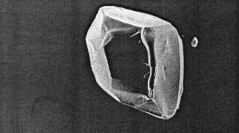

 Comptes Rendus Palevol
1 (3) - Pages 181-189
Comptes Rendus Palevol
1 (3) - Pages 181-189The exceptional prehistoric site of Dmanisi, in the South of Georgia, has yielded several hominid fossil remains, including three skulls and three mandibles assigned to Homo ergaster, in volcanic ashes and fluvio-lacustrine sands lying directly on a basalt flow. These levels also contain an archaic lithic industry consisting of pebble tools, cores and flakes, and large mammal remains attributed to the beginning of the Lower Pleistocene (Biharian). The basalt flow has been previously dated to about 1.85 Ma, but the overlying volcanic ash level had not yet been dated. In this paper, we present 40Ar/39Ar dating of plagioclase and glass from the volcanic ash level that has yielded Quaternary fauna, lithic artefacts and several human remains, which gives an age of 1.81±0.05 Ma. The subcontemporaneity of Hominid presence and volcanic ash deposition makes Dmanisi the oldest prehistoric site currently known in Europe and proves human presence at the gates of Europe 1.81 Ma ago.
Dmanisi, Georgia, Homo ergaster , earliest occupation of Europe, 40 Ar/ 39 Ar dating